Young drivers
Drivers under 25 make up the largest proportion of people involved in accidents. As driving is complex and relies on experience as a teacher, young drivers’ lack of experience increases the risk. Young drivers can react more quickly to simple hazards, but don’t understand complex hazards until it’s too late.
Young drivers often can’t afford cars that have better safety features; they end up with small cars that are cheap and under-powered so that they can afford to purchase and insure them. Safety features such as anti-lock brakes and electronic stability control cut the risk of accidents, but many older cars don’t have them.
Young drivers:
- often over-estimate their skills
- are less likely to use seat belts
- are more likely to be distracted
- have a greater desire to meet the time expectations of their employers
- are more susceptible to peer pressure from passengers and media
- are more likely to want to use technology in their vehicles such as mobile phones.

Using a mobile phone increases your risk of having an accident
For more information about the risks young drivers take, click here.
Disorganised people
People who manage their time poorly and are generally disorganised tend to rush around to compensate and this increases their chances of having an accident. They are less likely to do things in a logical order. Whereas an organised driver will set the satellite navigation before they set off, disorganised drivers will already be late and will try to do it while they are driving, which is a big distraction.
Drivers who drive for work
Drivers driving for work are at more risk for a number of reasons, some of which are made worse by their employers:
- Scheduling – work schedules aren’t always made with the driver in mind, they’re made with the client in mind. This could mean long days, or inconvenient driving times. It might mean shift work in some industries, and that increases the risks of fatigued driving. Pressures to make deliveries or get to meetings on time can lead to risk-taking.
- Distractions – thinking about the meeting you’re going to, or the meeting you’re coming back from. Worrying about work pressures and stresses can preoccupy a person’s thinking and make them slower to react to hazards.
- Vehicle familiarity – a person driving a work vehicle perhaps isn’t as familiar with it as they are with their personal vehicle (depending on how much they drive it). Simple things like the indicator stalk being on the other side add mental overhead.
- Increased exposure – the simple act of driving for work means that you are on the road more and therefore your exposure to risk is increased.
- Cumulative fatigue – tiredness grows through the week until people can catch up with sleep on the weekend. This means that drivers are generally more tired towards Thursday and Friday.
Emotional drivers
- Anger and sadness: a study of 3500 drivers in the USA found that people that drive angry or sad increase their accident risk up to ten times.
- Optimists: optimist have a marginally increased risk because they tend to leave too little time and then have to rush
- Blamers: people that can’t accept blame for their own shortcomings tend to be slow learners about risk to themselves and others, whereas drivers that can take the blame learn from their mistakes and tend to be more adept at identifying and responding to risk.
- Present-orientation: people who live for the present, living for the moment, tend to take more selfish actions and are less likely to empathise or respond to situations where others are at risk. People who predominantly think about the past dwell on and learn from their mistakes, and people that predominantly think about the future are aware of risks that would affect their ideal scenario.
